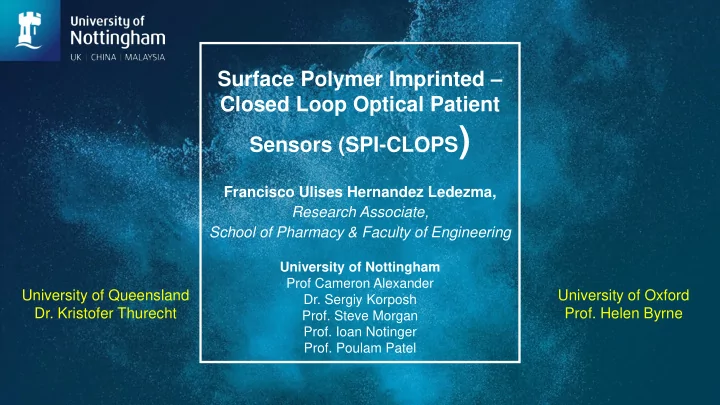

Surface Polymer Imprinted – Closed Loop Optical Patient Sensors (SPI-CLOPS ) Francisco Ulises Hernandez Ledezma, Research Associate, School of Pharmacy & Faculty of Engineering University of Nottingham Prof Cameron Alexander University of Queensland University of Oxford Dr. Sergiy Korposh Dr. Kristofer Thurecht Prof. Helen Byrne Prof. Steve Morgan Prof. Ioan Notinger Prof. Poulam Patel
OUTLINE • Background to the project • Background of Technology • Demonstration case of study • Progress to date • Conclusions and future plans
Background to the project • Lead BRAF inhibitors has dramatically improved outcomes for melanoma (Dabrafenib, Vemurafenib). • Sub-populations of patients treated with these drugs can become resistant. • No current way to predict which patients will develop resistant cancers. • No method to detect whether a patient’s tumour is receiving a therapeutic dose of drug. • Urgent need to evaluate in real time the molecular events occurring in tumours. Aims: • Accurate monitoring of dose and detection of resistance in cancer. • Develop an ambitious new healthcare technology, applicable to areas far Optical fibre beyond melanoma.
Objectives for the project (O1) Develop polymer-coated optical fibre long period gratings to detect Dabrafenib in serum. (O2) Derive 2D and 3D cultures of BRAF sensitive cells and validate Dabrafenib monitoring in extracellular milieu. (O3) Interface recognition polymers with optical fibre based sensors which can detect local changes in pH, and test readouts from fibres in 3D tumour spheroids. Long term: 2 nd Cyclops round Initial 6 months: Basic technology Detect BRAF inhibitors and suitability for models linking drug concentration. BRAF suppression and extracellular pH. Testable hypotheses relating dosing to cell response and resistance.
Background – size and working principle of technology Long Period Grating (LPG): SEM optical fibre A wavelength encoded sensitive sensor Wavelengths attenuated 100 100 Transmission [%] Transmission [%] 90 90 Bundle optical fibres 80 80 70 70 650 700 750 800 850 900 950 1000 650 700 750 800 850 900 950 1000 Wavelength [nm] Wavelength [nm]
Novelty of the research Advanced fibre-optic sensors with polymer coatings No current sensor material for drugs BRAF inhibitors. No existing technology for online monitoring (real time). Current offline methods for quantification : ∗ 1. HPLC / UV (200 ml plasma sample). 2. LC / MS (50 or 10 ml plasma sample). * Jean-Claude Alvarez et al. Journal of Pharmaceutical and Biomedical Analysis. 97 (2014) 29-32
Demonstration of the Layer-by-Layer method Experimental set-up Cell Light Spectro- source meter LPG Light source Spectrometer LPG Visualization Optical fibre in PC Deposition cell
Demonstration of the Layer-by-Layer method Statistical LoD=15.1 nm 𝐡 𝐧𝐧 𝟑 Theoretical LoD= 𝟐𝟗. 𝟘 𝐪 Case of study: Biotin-streptavidin (SV) interaction
Concept for the project & experimental plan 1. Polymers prepared to bind Dabrafenib using molecular imprinting and related techniques based on methods developed in the Alexander, Korposh and Piletsky labs. 2. Resultant polymers immobilised on surfaces of optical fibres with LPGs from the Morgan lab.
Experimental plans 1. Passivation with poly(ethyleneglycol)- co-poly(methacrylic acid) will provide a hydrophilic ‘steric shield’ resistant to protein adsorption but permeable to dabrafanib. 2. First generation fibre sensors tested for detecting drug levels in buffer solutions, serum with extracellular matrix components and in blood. 3. Cancer cell lines susceptible to BRAF inhibitors and those known to have acquired resistance will be cultured as 3D spheroids. 4. Fibres will be inserted into the spheroids and in situ monitoring of dabrafenib carried out following drug infusion to the spheroids.
Progress to date Experiments October-December 2017
First stage of the project Silanized optical fibre Silanization homogeneity influences surface polymer imprinting bare fibre silanized fibre 100 95 90 Transmission [%] 85 80 75 70 65 60 680 684 55 700 750 800 850 900 Wavelength [nm] 2 steps silanization protocol: Hydroxilation + silane agent (3-(trimethoxysilyl) propyl methacrylate) at 5 % (v/v) in solvent (MetOH/ 𝐈 𝟑 𝐏 , 95 : 5).
First stage of the project: Surface imprinting (photopolymerization) Glass sylanized Silica glass 100 + + 90 80 ATR [%] 70 Poly(ethylene glycol) methacrylate Methacrylic 60 Ester 50 (PEGMA) acid (MAA) Acrylate carboxyl 40 Absorption 30 of C=C acrylate 20 4000 3500 3000 2500 2000 1500 1000 -1 ] + Wavenumber [cm Dabrafenib BRAF- Inhibitor 100 2-Aminoquinoline 90 80 ATR [%] 70 60 Current work: Glass sylanized Translation to 50 Silica glass Exploration of polymer ratios 40 LPG fibre surface Imprinted to increase sensitivity 30 60/40 (PEGMA/MAA) 60 wt% 20 4000 3500 3000 2500 2000 1500 1000 -1 ] *next trials will include Ethylene glycol dimethacrylate Wavenumber [cm
Extension of the project to monitor in vitro 3D cancer model Second phase: Monitoring system in 3D tumour mimics. Drug delivery (dabrafenib concentration) & tumour properties (pH) Optical fibre (drug monitoring) Optical fibre (pH monitoring) Spectrometer “3D tumour spheroids: an overview on the tools and techniques used for their analysis” Elisabete C. Costa et al. Biotechnology Advances 34(2016) 1427-1441
Summary slide Conclusions so far: Optical fibres with LPGs readily fabricated in the Faculty of Engineering. Silanization of silica surfaces. Key results and success: Protocol for homogeneous silanization & molecular imprinting of 2-aminoquinoline using photopolymerization. Current work: Testing different ratios of PEGMA/MAA for imprinting 2-aminoquinoline and characterization. Future plans (April 2018): Translation to LPGs surface and tests for drug detection in serum. SiO 2 NPs functionalization and implementation of the Layer-by-Layer Method. Implementation of best sensor system with cell cultures and monitor pH levels vs drug levels.
ACKNOWLEDGMENTS: EPSRC (Grant EP/N026985/1) Prof Cameron Alexander, Dr. Sergiy Korposh, Prof. Steve Morgan, Prof. Poulam Patel, Colleagues from B15 and Optics&Photonics. B15 laboratory Optics and Photonics School of Pharmacy Faculty of Engineering
Recommend
More recommend